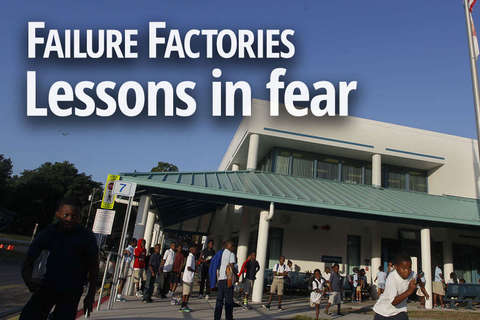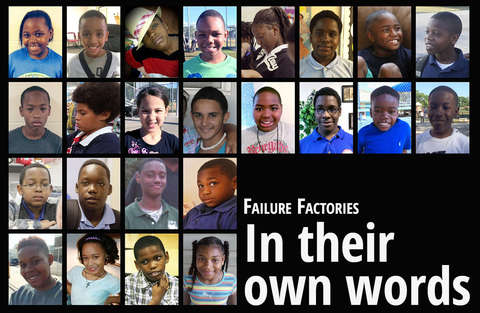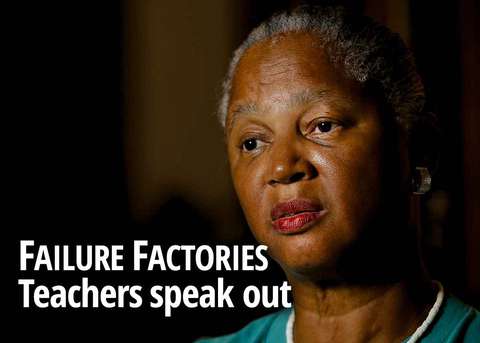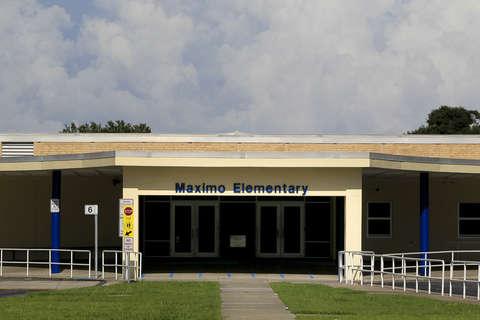Who’s my teacher today?
In St. Petersburg’s worst schools, your teacher likely has less experience or a troubled past. Many simply quit.
James Sampson had so many teachers at Melrose Elementary that the 9-year-old couldn’t keep them all straight.
He started the year with Ms. Davis, but by the fourth day of school he had Mr. Ware. Then came Ms. Flynt, Ms. Schick, Mr. Graveley and Ms. Smith. In all, James had a dozen different fill-ins between August 2014 and June 2015. More than a quarter of his school year was taught by substitutes.
It used to be that Melrose had no trouble keeping good teachers in the classroom.
But when Pinellas County School Board members ended integration efforts in 2007, they touched off a mass exodus of veteran teachers from five schools that became almost entirely poor and black.
Rather than take action to stabilize the teacher ranks at Melrose, Campbell Park, Fairmount Park, Lakewood and Maximo elementary schools, board members and district leaders ignored the problem for years — even as the schools devolved into five of the worst in Florida.
They offered few incentives to keep seasoned teachers at the schools.
They replaced the ones who fled with recent graduates who had never taught before. They forced them to take on some of the county’s most challenging students with no extra training or support.
Then they watched, year after year, as those new teachers drowned in the pressures of the job. Some suffered emotional breakdowns. Others skipped work to avoid the stress. Most left the schools the first chance they got.
Today, a Tampa Bay Times investigation has found, black children in the county’s most segregated schools get worse teachers than children anywhere else in the county.
Using state and district personnel records, Times reporters compared teachers hired by the five resegregated schools with those hired at schools in wealthier, whiter neighborhoods.
They found teachers in the whiter schools are more experienced, more likely to stay in their jobs and more likely to have clean employment records.
Teachers in the mostly black schools are less experienced, more likely to quit and more likely to have been flagged for incompetence or misconduct.
It’s not unusual to see dysfunction at schools wracked by poverty. But reducing teacher turnover at these five schools was within the district’s control.
“We told them every year that we needed more help,” said Mary Anna Matthews, who taught at Campbell Park for 23 years before opting to retire in 2010. “It was a systematic poisoning. If there had been a concerted effort to destroy Campbell Park, they couldn’t have done it better.”
Recent actions by superintendent Mike Grego show how the district might have addressed the problem. In just two years, Grego cut turnover nearly in half. All it took, he said, was making it a top priority. He started by putting experienced principals in charge and keeping them there to build up a loyal staff. Then he added classroom aides and steered the schools more counselors and social workers.
In an interview with the Times in May, Grego recalled the situation he inherited when he started. “We had almost all new people at these schools. I was like pulling my hair out, saying, ‘You can’t do this!’ ” he said. “Every inch and pound of research will tell you to place experienced and well-trained teachers” at struggling schools.
Since then, Grego said, the district has “turned the corner.”
In the past, more than half the teachers at the schools quit every year, he said.
Now that number is down to one in three.
Any improvements are coming late for James Sampson.
As he struggled through the second grade, he could barely read or do math. Often he came home frustrated and confused, said his mother, Tameka Lindsey. One teacher would tell him to count on his fingers, she said. Another instructed him to do the math in his head. A third would play on her cellphone rather than teach lessons.
The result was constant instability that gave way to tantrums, flipped desks and disruptions, making it all but impossible for James and his classmates to learn.
“When you get one consistent teacher, you know what to expect out of the teacher,” Lindsey said. “Every child doesn’t learn the same. If you’re only there one or two days, how can a child learn?”
North versus south
For decades, the school district bused children around Pinellas County to keep schools racially integrated. As recently as 2006, no school was more than 48 percent black.
That ended the following year, when School Board members voted to halt integration efforts and return to neighborhood schools.
Ten elementary schools, all in St. Petersburg, were affected most. Five on the city’s north side — Blanton, John M. Sexton, Northwest, Sawgrass Lake and Shore Acres — became much whiter.
The five neighborhood schools on the city’s south side became almost entirely black.
On the day of the School Board decision, Dec. 18, 2007, teachers in the southside schools were roughly as experienced as teachers in the northside schools.
About 15 percent were in their first year teaching compared to 10 percent in the northside schools. About a fifth had 20 years experience or more, compared to about a quarter in the schools to the north. On average, 23 percent of teachers quit every year, compared to 19 percent to the north.
But as the schools in black neighborhoods became poorer and more segregated, the district steered them no extra counselors, specialists or social workers and offered no bonuses or incentives.
Teachers in the schools were quickly overmatched by disruptions, bad behavior and other problems stemming from poverty.
Myrna Starling was about 25 years into a teaching career at Maximo Elementary when the board resegregated the district. For most of that time, “Maximo was the best school in the universe,” Starling said.
But then working conditions became more and more toxic.
“It became a battlefield for me,” said Starling, now 61. “I couldn’t take it anymore.”
She took an early retirement in 2010 rather than remain at the school any longer.
A flood of her peers did the same. More than 100 teachers with 10 or more years’ experience have left the five schools since 2008, a Times analysis showed.
They were overwhelmingly replaced by younger instructors who almost never lasted long.
Many left as soon as they could, forcing principals to replace a quarter or more of their staffs every year.
Principals at the southside schools had to hire about 550 teachers in the past five years. The north side schools had to hire about 230 in the same period.
Resisting incentives
Between 2008 and 2012, the southside schools became the county’s poorest and most challenging places to work. But during that time, district leaders offered their teachers no extra money or resources.
Clayton Wilcox, who was superintendent when the district ended integration, said in 2007 that he was against incentive pay for teachers in the southside schools.
“I want people who are there for the right reasons,” Wilcox said at the time. “I don’t want them there because they’re making $5,000 extra.”
For years, that thinking held sway, helped along by a county teachers union that often resisted the notion of paying certain instructors more than others.
The district offered special training programs at hard-to-staff schools from time to time, but they never lasted for long.
In 2011, School Board members complained about spending roughly $1 million a year to maintain a teacher training partnership with the University of Florida. The initiative offered a free master’s degree to teachers who stayed at struggling schools, including the five in south St. Petersburg, for five years.
A study later would show that students of teachers trained by the program in districts across Florida — including Pinellas — do 8 percent better than expected on standardized reading tests and 23 percent better in math.
But soon after agreeing to fund the partnership, the board fired then-superintendent Julie Janssen, and John Stewart, the interim superintendent who replaced her, quietly dismantled the training program.
As recently as January, board members expressed reluctance to pay for another program to help teachers at the five schools. Some members questioned the $1 million price tag to train teachers in managing student behavior.
“It sounds good, don’t get me wrong, but it’s a lot of money for coaching about effective teaching,” Chairwoman Linda Lerner said during a board meeting.
Board members approved the program in part because it wasn’t costing them local operating dollars. It was funded by federal money earmarked for poor children.
It wasn’t until 2012 that the district tried paying bonuses to teachers at the south St. Petersburg schools.
The district began offering about $1,000 per teacher at four of the five schools. Top performing teachers at Fairmount Park and Lakewood each were eligible for as much as $2,500 on top of that.
About a year later, Grego raised recruitment pay to $3,000 per teacher at Fairmount Park, Maximo and Melrose but didn’t offer it at Campbell Park or Lakewood.
Starting salary for a teacher in Pinellas is $40,000.
This year, for the first time, teachers in all five south side schools began getting $3,000 recruitment bonuses. They’ll be eligible for another $4,000 bonus if they stay in the schools at least three years.
By comparison, teachers who work in the district’s International Baccalaureate college prep program — which educates almost no black children — have earned thousands more for decades. Their bonuses are paid as a percentage of their salary. On average they each get $6,000 a year. A district spokeswoman said it’s compensation for working through their planning periods.
Other large, urban school districts are paying much more than Pinellas to attract teachers to low-performing schools.
Duval County is raising $50 million to pay teachers in its struggling schools incentives of as much as $20,000 each.
Miami-Dade County used federal money to pay top teachers, including those in its struggling schools, bonuses of as much as $25,000 each.
Hillsborough County pays teachers in some struggling schools up to $9,400 in incentive pay, retention bonuses and other extras.
None of these districts has problems on the scale of Pinellas — where five of the state’s 15 worst elementary schools are clustered in the county’s black neighborhoods.
Compromises
Kailel Rohlsen-Jackson got lucky in his last year at Melrose Elementary. His fifth-grade teacher was Kimberly Lopez, who was the county’s 2015 teacher of the year.
Most of his other teachers were a different story.
In 2008-09, his kindergarten instructor called in sick 23 times, leaving him to learn from a revolving door of substitutes.
His second grade teacher was reprimanded for dragging a child by the arm. The teacher got in trouble a second time for leaving students unsupervised.
A year earlier, Kailel’s P.E. teacher was disciplined for threatening to punch a second-grader in the face for sneezing.
His third-grade teacher was cut from the school at the end of the year for poor job performance.
His fifth-grade music teacher failed state certification exams seven times in seven years.
His fifth-grade art teacher was let go after she couldn’t stop breaking down and crying in front of students.
Kailel’s mother, Tawana Rohlsen, said she had only positive interactions with instructors at Melrose. But she was taken aback when the Times told her about the work histories of her son’s former teachers. “That’s not something that they advertise,” she said. “It’s almost like they’re putting the worst of the worst in the worst school.”
Any child can get a bad teacher once in awhile.
But rarely do students in wealthier, majority-white schools get a string of troubled teachers like Kailel’s.
The constant struggle to hire teachers into Pinellas County’s black neighborhoods means principals regularly take chances on instructors other schools don’t have to consider.
It starts with teachers who have no experience.
Far more so than other schools in the county, Campbell Park, Fairmount Park, Lakewood, Maximo and Melrose rely on first-year teachers to fill out their staffs.
The five southside schools hired 56 percent more rookies in the past five years than all other elementary schools in the county.
In 2013-14, 11 schools — almost all of them clustered in wealthier, white enclaves — had no first-year teachers at all.
Curtis Fundamental Elementary, which has been A-rated since 2001 and where about 80 percent of students are white, has hired only one rookie teacher in the past five years.
Principals at the southside schools acknowledge that their teachers aren’t the most experienced, but they say they work hard and perform well.
“We have and keep the very best teachers. They are young. Many of them are young,” Fairmount Park principal Nina Pollauf said at a community meeting in September. “But just because they don’t have 10 or 15 years’ experience doesn’t mean they’re not the highest quality teachers.”
But research has shown that students don’t learn as much from teachers who are just starting their jobs.
“There have been a dozen studies that look at this,” said Eric A. Hanushek, a national teacher quality expert at Stanford University’s Hoover Institution. “I don’t think there’s any doubt in anybody’s mind that the first couple years are more difficult, and teachers do more poorly, than later on.”
When the segregated schools have been able to hire more experienced teachers, it’s often because other schools had an option to hire them first — and passed.
As one gauge of teacher quality, Times reporters reviewed a database of more than 2.5 million state teacher certification test results and studied how Pinellas instructors fared.
They found the southside elementary schools were 50 percent more likely than all other Pinellas elementary schools to employ a teacher who had failed state exams at least once.
The state’s three main licensing tests measure basic reading and math ability as well as knowledge of teaching methods, among other things.
About 82 percent of all teachers in Florida pass all three tests on the first try, according to data from the state education department.
Many who fail once or twice go on to have productive teaching careers. But state officials acknowledged in 2004 that their data showed children learn less from teachers who have failed exams three or more times.
In Pinellas County, such teachers are disproportionately clustered in the five most segregated elementary schools.
On average, the south St. Petersburg schools hired about four times as many chronically failing teachers in the past five years as the district’s other elementary schools, a Times analysis showed.
About 260 elementary school teachers hired by the district in the past five years failed certification exams four or more times. More than 50 of those teachers went to work in the five elementary schools in the county’s black neighborhoods.
Some instructors at the schools struggled for years before passing all three tests.
One, a first-grade teacher at Maximo, failed the state general knowledge, professional education and subject area tests at least 18 times between 2007 and 2011.
Good teachers at the schools sometimes felt frustrated by their colleagues.
In five years teaching at Maximo, Kristen Yeckley said most of her co-workers were effective teachers who worked hard. But she said a few had no business being in front of a class. She recalled one first-grade instructor who would lock a boy out of the classroom rather than deal with his bad behavior.
“He would be in the hall, running and throwing himself into the door repeatedly,” Yeckley said.
It happened so often that Yeckley finally called the boy’s mother.
“I told her we might be doing irreparable harm to your son, and if it was my son I would find another address and move him,” she said.
The mother pulled her son from the school and enrolled him in Pinellas Park Elementary, where he did “fabulously,” Yeckley said.
Troubled records
Faced with high turnover, Pinellas County’s most segregated elementary schools also have hired teachers with troubled pasts.
They include instructors who have badgered co-workers, committed minor crimes and become physically aggressive with children.
Zema Florence III arrived at Melrose in 2008 with a history of sexually harassing co-workers.
At his former school, Woodlawn Elementary, he was disciplined for leering at a fellow employee from the doorway of her classroom, winking and smiling if she made eye contact — and for making comments about the kinds of jeans he thought would look good on her.
Nine months into his new job at Melrose, Florence was in trouble again — this time for allegations involving students. His fourth-graders accused him of constantly hugging and touching some girls and calling others “stupid,” “idiot,” “retard,” and “fatty,” personnel records show. They said he regularly pressed girls to his body against their will, sometimes as often as 15 times a day, and he pinched their cheeks and touched their faces.
He offered one fourth-grade girl $200 to keep her quiet, personnel records show.
After that, the district transferred him again — to Maximo. He resigned the following year, 2010, citing personal reasons. He no longer works for the district and could not be reached for comment.
Candice Shores had problems nearly everywhere she worked in Pinellas before Melrose hired her in 2014. She was forced to resign from Gibbs High by administrators who told her she wasn’t suited to work in a majority-black school.
The white 61-year-old then was banned from substituting at Lealman Intermediate after she was cited for mocking a special-needs child for sucking his thumb and then accused the black principal of racial bias, personnel records show.
She quit five weeks after starting at Melrose, saying the working conditions were elevating her blood pressure to dangerous levels.
Reached by the Times, Shores described long hours and a thankless work environment at the southside school. “Every day was hell,” she said.
Mikal Guthrie was banned as a substitute at Lealman Avenue Elementary in February 2000 after teachers complained she used inappropriate language in the classroom and passed the time reading silently rather than teaching lessons, her personnel records show.
She was banned from subbing at Blanton Elementary in April 2000 after several parents complained about how she disciplined their children.
She was banned from subbing at Pinellas Park Elementary in 2003 for using her cellphone to make personal calls during class, reading a newspaper instead of teaching lessons and rifling through teachers’ belongings.
She was banned from subbing at John M. Sexton Elementary in 2008 for refusing to allow students to use the bathroom and for forbidding a girl from seeing the nurse to get needed medication.
She worked four years as a part-time instructor in St. Petersburg schools before Lakewood Elementary hired her as a full-time teacher last fall.
Principal Cynthia Kidd said in an email that Guthrie had great reviews from her time as an hourly teacher at Woodlawn Elementary. She described her as a hard worker who “gives freely of her time to ensure students are taken care of academically and emotionally.”
Until recently, principals at the south St. Petersburg schools had no choice but to hire teachers who struggled at other schools.
Under a deal negotiated by the teachers union, administrators had to fill openings from a pool of teachers who were transferred involuntarily from other schools in the district.
Some in the pool had lost their jobs because their schools closed or student enrollment dropped. But others were forced out because of poor performance.
From 2008 to 2012, the southside schools hired 45 teachers from the district’s involuntary transfer pool. During the same period, the five schools on the north side of St. Petersburg hired 28, the Times found.
With teacher union support, the deal remained in force until two years ago.
Superintendent Grego negotiated to end the arrangement soon after he was hired. Then he loosened up hiring and firing at the segregated schools, giving principals authority to dismiss teachers at will and allowing teachers to walk away from the schools more easily.
In an interview with the Times, he called the moves basic steps to stabilize the schools’ teacher ranks.
“These are things that have been in place in many of these other districts for over 10 years,” he said. As an administrator in Hillsborough County schools, “I had these things in place in 1999 and 2000.”
Last week, district leaders told the Times they plan to lend the schools district staff to help screen job candidates. That, they said, will help “ensure a higher level of scrutiny in selecting the best candidates for their schools.”
A substitute for learning
Even when teachers are fired or cut from the schools for poor performance or misconduct, it’s no guarantee they won’t be back in southside classrooms right away — as substitutes.
Zariyah Durant had two different teachers in the third grade at Maximo in 2013. They missed a combined 30 days of work that year.
One of the subs who regularly filled in was Hyacinth Dyer, who failed state certification exams 12 times in five years and was dismissed twice as a teacher at Melrose for her inability to obtain proper certification.
Another was Lige George, a former P.E. teacher who failed parts of the state general knowledge exam four times in 2011 and who was cut from Fairmount Park after he was disciplined for roughly grabbing a girl by the arm, according to district personnel records. After that, he was hired by Melrose as a second-grade teacher, but the principal cut him from the staff a year later.
Neither Dyer nor George could be reached for comment.
They weren’t the only examples. A Times analysis of district staffing records found that teachers dismissed from the southside schools have returned as substitutes in the same schools more than 250 times in the past five years.
Zariyah said the constant shuffle at Maximo made it hard to learn. None of the substitutes seemed able to control the classroom, she said.
“A lot of people were cussing, standing on desks,” Zariyah said last year. “They were hitting teachers on the back and the head.”
She wanted to focus on her work, but the disruptions that year proved too much for the little girl.
When it came time to take standardized tests in the spring, she tried to remember what she had learned, but she often couldn’t summon the correct answers.
In the end, she had to repeat the third grade.
Times staff writer Lisa Gartner and data reporter Nathaniel Lash contributed to this report. Contact Cara Fitzpatrick at [email protected]. Contact Michael LaForgia at [email protected]. Contact Adam Playford at [email protected].
This article was written while Times reporter Michael LaForgia was participating in the National Health Journalism Fellowship, a program of the University of Southern California’s Annenberg School of Journalism.
This story was updated on Oct. 24 to reflect the following clarification: Florida’s general knowledge examination for teacher certification includes tests for four different subjects. Lige George sat for the general knowledge exam twice before passing.
About the data
To examine the quality and experience of teachers in Pinellas County schools, the Tampa Bay Times obtained more than a dozen databases from the state Department of Education and the Pinellas County School District.
Totaling more than 6 million rows, the records included data on where teachers work, their hiring and firing dates, years of experience, state certification exam results and substitute teacher assignments.
Times reporters wrote computer software to link the databases, then compare schools across the county based on teacher turnover, longevity and other factors.
Because of the way the data on teacher certification exams is kept, the Times could not determine a test score for every teacher. Numbers are based on matching 60 percent of teachers across the county.




Join the conversation
Add your thoughts